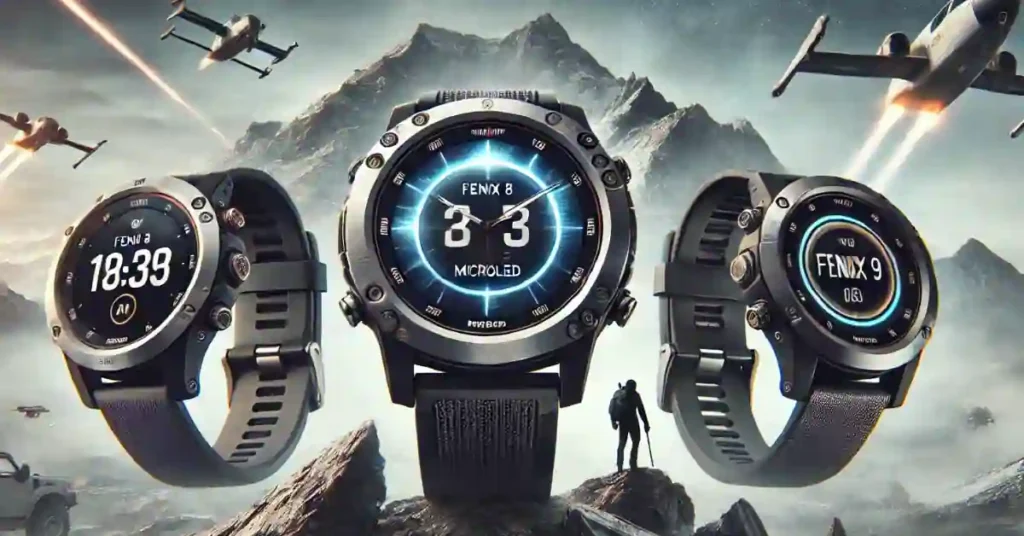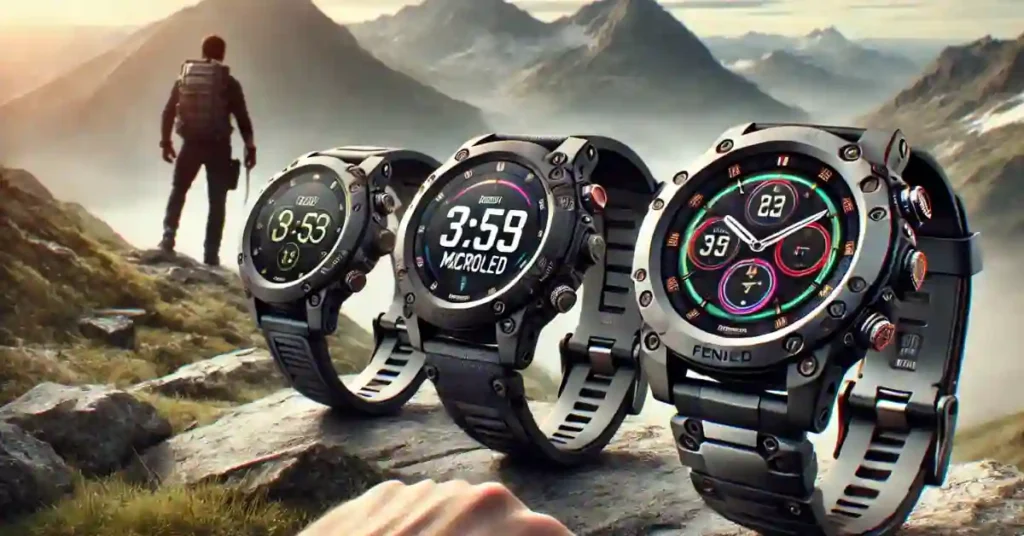Garmin is set to expand its premium smartwatch lineup, and recent leaks suggest that exciting upgrades are on the horizon.
Following the launch of the Garmin Instinct 3, and the new Tactix 8 attention has now shifted to the upcoming Fenix 8 Pro and Fenix 8 MicroLED models—both of which could introduce major display, GPS, and health-tracking advancements.
Meanwhile, speculation is growing about the Fenix 9, which could mark a significant leap in wearable technology, potentially integrating MicroLED displays, non-invasive glucose monitoring, and enhanced satellite connectivity.
Let’s take a closer look at what we know so far about Garmin’s next-generation smartwatches.
Expected Release Dates for Garmin Fenix 8 Pro, Fenix 8 MicroLED & Fenix 9

Garmin has maintained a consistent release cycle for its Fenix line, typically launching a new generation every two years.
Here’s a look at past releases and what we can expect moving forward:
| Model | Release Date | Sensor/Feature |
|---|---|---|
| Fenix 5 | January 4, 2017 | Elevate V2 |
| Fenix 5 Plus | June 18, 2018 | Added maps, music, and payments |
| Fenix 6 and 6 Pro | August 29, 2019 | Elevate V3 |
| Fenix 6 Solar | July 8, 2020 | Introduced solar charging |
| Fenix 7 | January 18, 2022 | Elevate V4 |
| Fenix 7 Pro | May 31, 2023 | Elevate V5, released alongside Epix Pro |
| Fenix 8 | August 27, 2024 | AMOLED or MIP display options; Solar models feature MIP |
| Fenix E | August 27, 2024 | Elevate V4, a budget-friendly option |
Typically, there’s a new generation every two years, with some mid-cycle updates. The mentions of Fenix 8 Pro and Fenix 8 MicroLED have already appeared on a page showing compatible devices for Garmin Connect.
Fenix 8 Pro Release Expectations
Based on Garmin’s past release cycles, the Fenix 8 Pro is expected to launch by mid-2025, likely in the summer.
Historically, Garmin has introduced Pro versions about a year after the standard models, making this timeline plausible.
However, the Fenix 8 MicroLED could face delays due to production challenges, pushing its release to late 2025.
Garmin Fenix 8 Pro: What to Expect
Garmin’s Pro models retain familiar designs but introduce significant upgrades. Based on past trends, we can expect the Fenix 8 Pro to feature:”
- A higher resolution display with improved sunlight visibility.
- An enhanced Elevate 6 sensor for more accurate health tracking.
- Longer battery life, possibly extending beyond previous models.
- Better GPS accuracy, with faster satellite lock-on times.
Expected Release Dates for Garmin Fenix 8 Pro, Fenix 8 MicroLED & Fenix 9

MicroLED technology in the Fenix 8 MicroLED could revolutionize smartwatch displays. Unlike traditional LCD and OLED screens, MicroLED offers superior brightness, higher contrast, and improved energy efficiency.
However, its high production costs might push the price of this model significantly higher, possibly exceeding $1,500.”
Regarding battery life, MicroLED is more energy-efficient, but overall usage time will depend on the watch’s power draw.
If done right, we could enjoy extended battery life without compromising display quality.
MicroLED vs. OLED & MIP Displays
- Brighter & Sharper – MicroLED delivers higher contrast and better visibility in sunlight.
- More Energy-Efficient – Consumes less power than OLED, improving battery life.
- Longer Lifespan – MicroLED screens don’t degrade over time like OLED.
Potential Downsides
- Higher Cost – Manufacturing MicroLED displays is expensive, possibly pushing the price to $1,500+.
- Production Delays – Due to its complex manufacturing, Garmin may struggle with large-scale rollout.
If MicroLED proves successful, it could become the standard display technology in future Garmin watches, replacing the current MIP and AMOLED options.
Check out this in-depth comparison: AMOLED vs. MIP Displays in Garmin – Full Breakdown
Early Thoughts on the Fenix 9
While the Garmin Fenix 9 is still far off, industry trends and the latest leak from Smartwatch Insight hint at some groundbreaking features.
From enhanced battery life to advanced health tracking and possibly a new display technology, the next-gen Fenix could be a game-changer!
What the Fenix 9 Could Offer
- Standardized MicroLED Displays – If the Fenix 8 MicroLED succeeds, the Fenix 9 could feature it across all models.
- Blood Pressure & Glucose Monitoring – As wearable health tech advances, non-invasive tracking may become possible.
- Slimmer, Lighter Design – Garmin could reduce bulk while maintaining durability.
- Wireless Charging & Battery Efficiency – A true multi-week battery life with solar and wireless charging support.
- LTE & Satellite Messaging – Enhanced connectivity features for outdoor adventurers.
While it’s too soon to confirm specifics, the Fenix 9 will likely push boundaries in health tracking, battery efficiency, and display technology.
FAQs- What’s Next for the Garmin Fenix Series?
When is the Garmin Fenix 8 Pro expected to be released?
The Garmin Fenix 8 Pro is expected in mid-2025, following Garmin’s usual release cycle.
What makes MicroLED better than OLED or MIP displays?
MicroLED offers brighter colors, higher contrast, better energy efficiency, and a longer lifespan compared to OLED and MIP.
How much will the Fenix 8 MicroLED cost?
Given its premium technology, the Fenix 8 MicroLED could be priced above $1,500.
What new health features might the Fenix 9 include?
Potential upgrades could include blood pressure monitoring, glucose tracking, and improved heart rate accuracy.
Will the Fenix 9 have satellite messaging?
Garmin may introduce LTE and satellite messaging, improving off-grid connectivity for adventure enthusiasts.
Will Garmin discontinue the MIP display in favor of MicroLED?
If MicroLED proves successful, it could eventually replace MIP displays in Garmin’s premium models.


